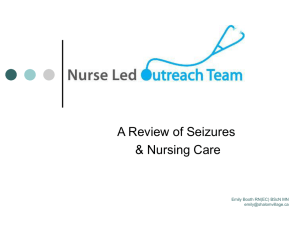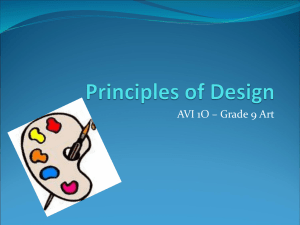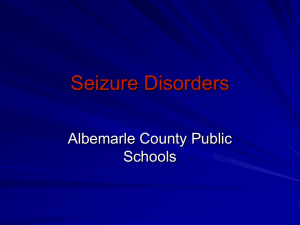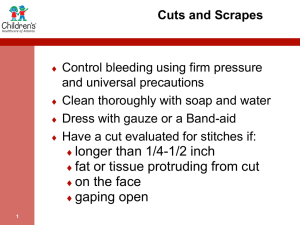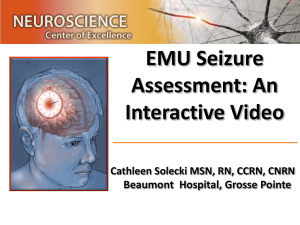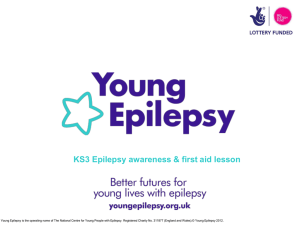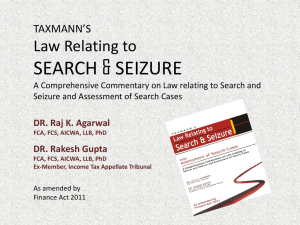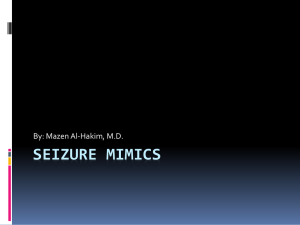Seizures
advertisement
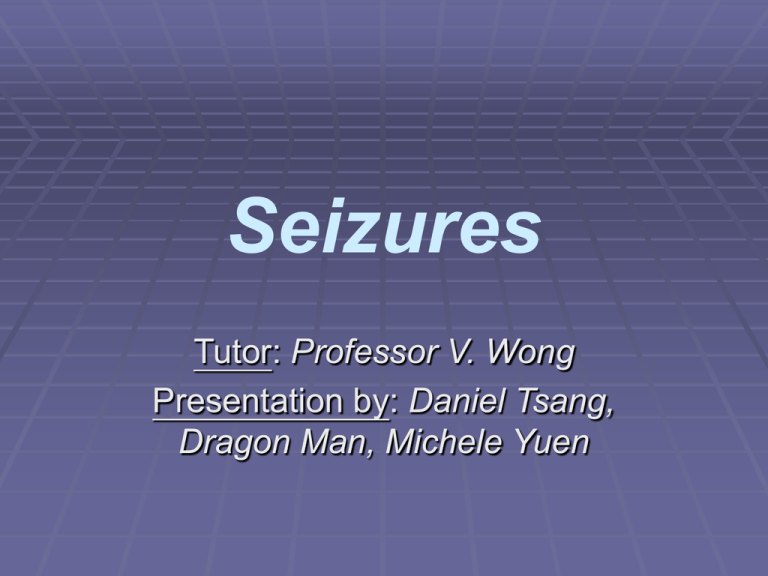
Seizures Tutor: Professor V. Wong Presentation by: Daniel Tsang, Dragon Man, Michele Yuen Outline of Presentation 1. Some basic terminologies 2. Brief overview of seizures 3. Video demonstrations Part 1: Basic Terminologies Some stuff you probably know already… Epilepsy: group of syndromes characterized by paroxysmal transient disturbances of the brain function Seizure: a single episode of epilepsy Consciousness Consciousness: awareness or responsiveness to external stimuli Awareness: contact with events during the period in question Responsiveness: ability to carry out simple commands or willed movement Drowsiness or somnolence Drowsiness or somnolence: sleep state from which the patient can be aroused to make appropriate motor and verbal responses Stupor: state from which the patient can be aroused by painful or other vigorously applied stimuli to make avoidance movements Aura component of seizure which occurs before consciousness is lost and for which memory is retained afterwards In seizures that occur without lost of consciousness, the aura is the whole seizure Automatisms Involuntary motor activity occurring during the state of clouding of consciousness either in the course of, or after an epileptic seizure Continuation of an activity that was going on when the seizure occurred vs. new activity developed in associated with the ictal impairment of consciousness Related to discharge in the limbic system Types of Automatisms 1.Eating automatisms → Absence seizures 2.Automatisms of mimicry Complex partial + 3.Gestural automatisms absence seizures 4.Ambulatory automatisms 5.Verbal automatisms Part 2: Brief overview of seizures Classification of seizures Seizure Partial Simple 1. 2. 3. 4. 5. Motor Somatosensory Special sensory Autonomic Psychic Complex 1. Simple partial at onset 2. Impairment of consciousness at onset Generalized Secondarily Generalized 1. Simple to generalized 2. Complex to generalized 3. Simple to complex to generalized 1. 2. 3. 4. 5. 6. Absence Myoclonic Clonic Tonic Tonic-clonic Atonic Partial seizures Consciousness Hemispheric involvement Simple partial seizure Intact Unilateral; Bilateral involvement rare Complex partial seizure Impaired Primarily unilateral; often bilateral in course of seizure Simple partial seizure Several types: 1. With motor signs 2. With somatosensory or special sensory symptoms 3. Seizures with autonomic symptoms 4. With psychic symptoms Simple partial seizures with motor signs Strictly focal Spread to contiguous cortical area → sequential involvement of body parts “Epileptic march” / Jacksonian seizure Presentations: Head turns to one side (usually contralateral to discharge) Speech arrest / vocalization Epileptic palilalia Todd’s paralysis Epilepsia partialis continua Simple partial seizure with somatosensory or special sensory symptoms Somatosensory “pins-and-needles / numbness Proprioception or spatial perception disorders Special sensory Visual: flashing lights, structured visual halluncinations Auditory: crude auditory sensations, highly integrated functions (e.g. music) Olfactory: unpleasant odours Gustatory: crude (salty, sour, sweet, bitter), sophisticated (‘metallic’) Vertiginous: falling in space, floating, totatory vertigo Simple partial seizures with autonomic symptoms Vomiting Pallor Flushing Sweating Piloerection Pupil dilatation Borborygmi Incontinence Simple partial seizure with psychic symptoms Dysphasia: motor, sensory, global aphasia Dysmnesic: distortion of time sense, deja-vu, jamais-vu, deja-entendu, jamais-entendu, panoramic vision Cognitive disturbances: dreamy state, distortion of time sense, unreality, depersonalization Affective: extreme pleasure or displeasure, fear, anger, rage Illusions: objects appear deformed Structured hallucination Complex partial seizure Gradual impairment of consciousness (c.f. abrupt impairment in absence seizures) Presentations: Limited to impairment of consciousness With additional psychic, motor and autonomic symptoms Complex partial seizure - Types Complex partial seizure Temporal Extratemporal Start with an empty stare + Clouding of consciousness ↓ Automatism (oral, mimic, gestural, verbal) Frontal type: Fronto-cingular epilepsy Generalized seizures Absence seizures Sudden in onset, interruption of ongoing activities, blank stare Non-responsive Vanish in second Atypical Can associate with other components Tonus, clonus, automatism Myoclonic seizures Sudden, brief Generalized to individual muscle group Ddx Spinal cord, brainstem and cortices lesions Clonic seizure Generalized seizure sine tonic component Postictal phase is usually short May progress to tonic phase, clonic-tonicclonic seizure Tonic seizures Rigid, violent muscular contraction fixing the limbs in some strained position Deviated eyes, head towards one side, alteration in posture Pale, flushed and ultimately livid Tonic-clonic seizures Vague ill-described warning Tonic phase: Sudden, sharp, tonic contraction of muscles (+ stridor), cyanosis Fall on ground, tongue bitten, urine incontinence Clonic phase: Grunting drooling Deep respiration, all muscle relax, remain unconscious for variable time, Awake with soreness and drowsiness, deep sleep Atonic seizures Sudden reduction in muscle tone Head drop, slacking of jaw, dropping of limb or slumping to the ground Drop attack Ddx: brainstem ischaemia, narcolepsy Part 3: Video Demonstrations CS 2 D:\HMR_ROM1\AVI\CS2.AVI CS 2: Simple partial seizure with motor signs and march No loss of consciousness Rhythmic twitching of the fingers of the left hand, spreading through arm to shoulder He held his affected hand Simple partial seizure with motor signs Focal CS 12 D:\HMR_ROM1\AVI\CS12.AVI CS 12: Simple partial seizure with psychic symptoms and dysphasia With dysphasic symptoms Clicking of tongue, mumbling incomprehensible words and smiles Fully understand commands but unable to speak properly CS 15 D:\HMR_ROM1\AVI\CS15.AVI CS 15: Complex partial seizure, simple partial onset, impairment of consciousness Slight loss of postural tone Preserved orientation reflex Impaired consciousness CS 17 Patient was asked to hyperventilate in the beginning D:\HMR_ROM1\AVI\CS17.AVI CS 17: Complex partial seizure vs generalized absence Patient suddenly stopped hyperventilating Motionless and blank facial expression Regain consciousness with told nurse her had vague stomach sensation EEG: localized right frontal activity pre and postictally favours a partial seizure CS 19 Patient with right frontal ganglioglioma D:\HMR_ROM1\AVI\CS19.AVI CS 19: Complex partial seizure, impairment of consciousness at onset Sudden sat up and started to roll about Lying on his belly Manipulated his genitals (frontal automatism) CS 20 D:\HMR_ROM1\AVI\CS20.AVI CS 20: Simple partial seizure with secondary generalization Left arm started jerking Still responsive Coarse jerking of arms, stretching of back, tonic contraction of face, open mouth Loss of consciousness Twitching of all limbs and head Relaxation and postictal sleep CS 23 D:\HMR_ROM1\AVI\CS23.AVI CS 23: Typical absence seizure Slight loss of tone in neck muscle when stop hyperventilation Seizure started Mild eyelid clonus Regain responsiveness later CS 29 D:\HMR_ROM1\AVI\CS29.AVI CS 29: Generalized atypical absence seizure Head drop gradually Not responsive Later responded to staff and gradually regain upright position CS 30 D:\HMR_ROM1\AVI\CS30.AVI CS 30: Generalized myoclonic seizure Brief repetitive movements of the limbs CS 32 D:\HMR_ROM1\AVI\CS32.AVI CS 32: Generalized clonic seizure Opening of eyes and massive myoclonic jerks Continuous clonic movement of limbs Repetitive vocalization with clonic movement of the chest CS 33 D:\HMR_ROM1\AVI\CS33.AVI CS 33: Tonic seizure Gradual elevation of both hands and stopped walking Took 2 steps and then passed urine Bent body strongly forward but kept standing Dropped handkerchief CS 34 D:\HMR_ROM1\AVI\CS34.AVI CS 34: Tonic clonic seizure Suddenly bent forward with extended arm and legs Twitching in face and body Tonic stretching of arms and legs CS 35 D:\HMR_ROM1\AVI\CS35.AVI CS 35: Atonic seizures Sudden relaxation of muscles Head drop, floppy limbs and slumping to the ground Some more videos if we have time Otherwise, THE END. CS 27 D:\HMR_ROM1\AVI\CS27.AVI CS 27: Absence seizure With automatism Not necessarily specific for complex partial seizures D:\HMR_ROM1\AVI\CS24.AVI Absence with mild clonic component D:\HMR_ROM1\AVI\CS26.AVI Absence with tonic component Head mainly affected CS 3 D:\HMR_ROM1\AVI\CS3.AVI CS 3: Partial seizure with motor signs and march Complex partial seizure → partial motor seizure with secondary generalization Not a Jacksonian seizure: consciousness was impaired before the march starts CS 4 D:\HMR_ROM1\AVI\CS4.AVI CS 4: Simple partial seizure with motor signs and versive movements Sudden start of seizure from sleep Version of trunk towards the right Left arm bent at the elbow, fingers forcefully stretched Right arm beats on arm of chair to warn nurse Tonic contraction of face and eyes EEG: not interpretable due to artifacts (pseudospike waves) CS 13 D:\HMR_ROM1\AVI\CS13.AVI CS 13: Simple partial seizure with psychic, dysmnesic and affective symptoms and hallucinations Happily talking Deja-vu Spontaneous hyperventilation Facial expression of suffering with weeping and crying No loss of contact; can give age, date and name of objects Cries and yells; feels very bad and asks for help; weeps – affective sympoms THE END Questions?
